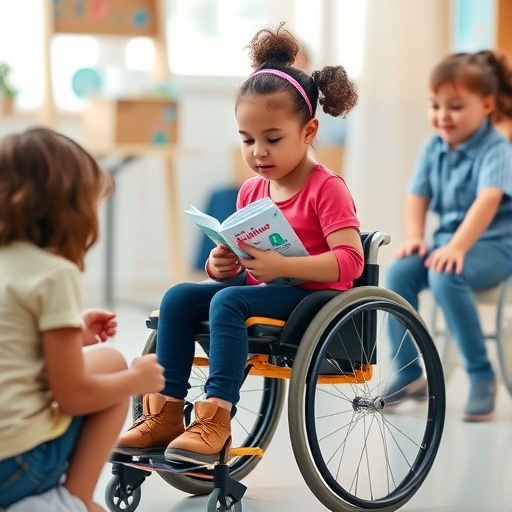In a groundbreaking study, researchers investigated the profound impact of multidisciplinary interventions on gross motor function and functional independence in children with disabilities in rural South India. The research, focusing on the Enabling Inclusion® program, highlights a pressing issue that has long been overlooked in many underprivileged regions—the need for effective rehabilitation programs tailored for children with disabilities. The intricate challenges faced by these children, paired with the socio-economic hurdles of their families, necessitate innovative approaches that go beyond traditional rehabilitation methods.
The Enabling Inclusion® program consists of a range of interventions designed to tackle the complexities surrounding disability in a comprehensive manner. By incorporating various therapeutic strategies—including physical, occupational, and speech therapy—this program aims to address the multifaceted needs of children with disabilities. The researchers underscore the importance of addressing not just the physical limitations that these children face, but also the psychological and social factors that accompany disabilities.
One of the standout features of the Enabling Inclusion® program is its multidisciplinary approach. This strategy involves a team of specialists working collaboratively to design and implement individualized care plans. By fostering cooperation among professionals from diverse backgrounds, the program ensures that all aspects of a child’s life are taken into account. This is crucial because disabilities can affect children differently, and a one-size-fits-all approach often fails to yield satisfactory outcomes.
Moreover, the study emphasizes the role of family and community in the rehabilitation process. The researchers believe that including parents and caregivers in the therapeutic interventions not only empowers families but also enhances the overall effectiveness of the program. By providing education and resources to families, the program ensures that the support extends beyond the therapy sessions. This holistic approach acknowledges that real-world environments significantly influence children with disabilities and their developmental trajectories.
As the study unfolded, it became evident that the impact of the Enabling Inclusion® program extends beyond mere physical improvements. Participants showed marked enhancements in gross motor functionality, which in turn facilitated greater independence in daily activities. The ability to perform tasks that others may take for granted—like dressing or playing—can dramatically change a child’s quality of life. Functional independence not only boosts self-esteem but also enhances social interactions, allowing children to engage more with their peers.
The findings reveal that children involved in the program experienced a gradual but steady improvement in motor skills, with many exceeding initial expectations. For instance, simple movements, once challenging for these children, became achievable milestones through consistent intervention. The researchers documented success stories that illustrate how personal achievements in gross motor skills translated into a newfound confidence among participants.
Additionally, the multidisciplinary training provided to caregivers is noteworthy. By equipping parents with the necessary skills and knowledge to assist their children outside of clinical settings, the Enabling Inclusion® program creates a sustained support system that positively impacts families. Families became advocates for their children, learning to navigate the healthcare system and seek resources that can further facilitate their children’s development.
As communities witnessed the benefits of these interventions, a cultural shift began to emerge. The research highlights an increased awareness regarding disabilities and the various forms of support available. The findings suggest that the Enabling Inclusion® program could serve as a model for other regions facing similar challenges. As more families learn about the positive outcomes, the stigma surrounding disabilities can begin to erode, leading to greater societal acceptance and opportunities for integration.
The researchers emphasize the importance of evidence-based practices in shaping future interventions. As they analyze the outcomes from their study, they hope to refine and enhance the program based on real-world results. This commitment to continual improvement ensures that the program remains relevant and effective, ultimately benefiting the ever-evolving needs of children with disabilities.
Despite the challenges noted in implementing such a comprehensive program in rural settings, the researchers remain optimistic about the potential for positive change. The combination of dedicated professionals, engaged families, and a community-oriented approach demonstrates that success is achievable, even in the face of significant obstacles. The study serves as a testament to the potential for transformation through targeted multidisciplinary interventions.
In conclusion, the Enabling Inclusion® program represents a beacon of hope for children with disabilities and their families in rural South India. By marrying evidence-based practice with a compassionate, multidisciplinary framework, the research highlights a sustainable model for intervention that prioritizes not only the rehabilitation of physical abilities but also the nurturing of independence. As these findings make waves in the scientific community, the implications for practical applications in similar regions could indeed pave the way for more inclusive societies.
In an era where awareness regarding disabilities has gained momentum, studies such as this remind us that there is still much work to be done. By shining a light on the difficulties faced by children with disabilities and those who care for them, the research reaffirms our collective responsibility to advocate for change. The vision of a world where every child has access to the support they need to thrive is not merely an ideal—it is an achievable reality with the right interventions and dedication.
The Enabling Inclusion® program’s success ultimately lies in its holistic, community-driven approach, showing that with compassion, collaboration, and commitment, we can unlock the potential of every child. As the program continues to evolve, it stands as a model of hope and progress for communities grappling with similar challenges, engaging families, and fostering environments that allow children with disabilities to flourish.
Subject of Research: Multidisciplinary interventions using the Enabling Inclusion® program on gross motor function and functional independence in children with disabilities in rural South India.
Article Title: Effect of multidisciplinary interventions using the Enabling Inclusion® program on gross motor function and functional independence in children with disabilities in rural South India.
Article References:
Bhrasadiya, N., Coutinho, F., Ramachandran, S. et al. Effect of multidisciplinary interventions using the Enabling Inclusion® program on gross motor function and functional independence in children with disabilities in rural South India.
BMC Pediatr 25, 960 (2025). https://doi.org/10.1186/s12887-025-06205-3
Image Credits: AI Generated
DOI: https://doi.org/10.1186/s12887-025-06205-3
Keywords: multidisciplinary interventions, children with disabilities, Enabling Inclusion program, gross motor function, functional independence, rural South India.
Tags: addressing psychological factors in disabilitycollaborative care for children with disabilitiescomprehensive approaches to disabilityEnabling Inclusion® program South Indiafunctional independence in disabled childrengross motor function improvementinnovative therapeutic strategies for disabilitiesmultidisciplinary interventions for disabled childrenoccupational and speech therapy for childrenrehabilitation programs for children with disabilitiesrural disability rehabilitation initiativessocio-economic challenges in disability rehabilitation





